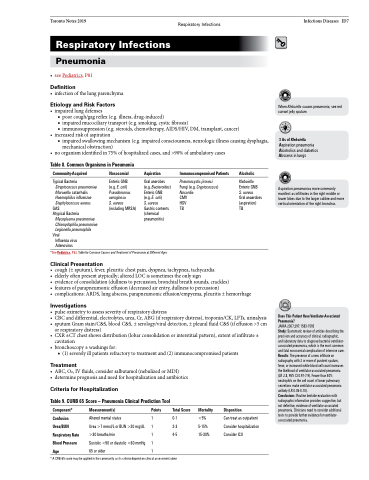Page 607 - TNFlipTest
P. 607
Toronto Notes 2019
Respiratory Infections
Infectious Diseases ID7
Respiratory Infections
Pneumonia
• seePediatrics,P81 Definition
• infectionofthelungparenchyma
Etiology and Risk Factors
• impairedlungdefenses
■ poor cough/gag reflex (e.g. illness, drug-induced)
■ impaired mucociliary transport (e.g. smoking, cystic fibrosis)
■ immunosuppression (e.g. steroids, chemotherapy, AIDS/HIV, DM, transplant, cancer)
• increasedriskofaspiration
■ impaired swallowing mechanism (e.g. impaired consciousness, neurologic illness causing dysphagia,
When Klebsiella causes pneumonia; see red currant jelly sputum
3 As of Klebsiella Aspiration pneumonia Alcoholics and diabetics Abscess in lungs
Aspiration pneumonias more commonly manifest as infiltrates in the right middle or lower lobes due to the larger calibre and more vertical orientation of the right bronchus
mechanical obstruction)
• noorganismidentifiedin75%ofhospitalizedcases,and>90%ofambulatorycases
Table 8. Common Organisms in Pneumonia
Community-Acquired
Typical Bacteria
Streptococcus pneumoniae Moraxella catarrhalis Haemophilus influenzae Staphylococcus aureus
GAS
Atypical Bacteria
Mycoplasma pneumoniae Chlamydophila pneumoniae Legionella pneumophila
Viral
Influenza virus Adenovirus
Nosocomial
Enteric GNB (e.g. E. coli) Pseudomonas aeruginosa
S. aureus
(including MRSA)
Aspiration
Oral anerobes (e.g. Bacteroides) Enteric GNB
(e.g. E. coli)
S. aureus
Gastric contents (chemical pneumonitis)
Immunocompromised Patients
Pneumocystis jiroveci Fungi (e.g. Cryptococcus) Nocardia
CMV
HSV
TB
Alcoholic
Klebsiella
Enteric GNB
S. aureus
Oral anaerobes (aspiration)
TB
*See Pediatrics, P82, Table for Common Causes and Treatment of Pneumonia at Different Ages
Clinical Presentation
• cough(±sputum),fever,pleuriticchestpain,dyspnea,tachypnea,tachycardia
• elderlyoftenpresentatypically;alteredLOCissometimestheonlysign
• evidenceofconsolidation(dullnesstopercussion,bronchialbreathsounds,crackles)
• featuresofparapneumoniceffusion(decreasedairentry,dullnesstopercussion)
• complications:ARDS,lungabscess,parapneumoniceffusion/empyema,pleuritis±hemorrhage
Investigations
• pulseoximetrytoassessseverityofrespiratorydistress
• CBCanddifferential,electrolytes,urea,Cr,ABG(ifrespiratorydistress),troponin/CK,LFTs,urinalysis • sputumGramstain/C&S,bloodC&S,±serology/viraldetection,±pleuralfluidC&S(ifeffusion>5cm
or respiratory distress)
• CXR ±CT chest shows distribution (lobar consolidation or interstitial pattern), extent of infiltrate ±
cavitation
• bronchoscopy±washingsfor:
■ (1) severely ill patients refractory to treatment and (2) immunocompromised patients
Does This Patient Have Ventilator-Associated Pneumonia?
JAMA 2007;297:1583-1593
Study: Systematic review of articles describing the precision and accuracy of clinical, radiographic, and laboratory data to diagnose bacterial ventilator- associated pneumonia, which is the most common and fatal nosocomial complication of intensive care. Results: The presence of a new infiltrate on radiography with 2 or more of purulent sputum, fever, or increased white blood cell count increases the likelihood of ventilator-associated pneumonia (LR 2.8, 95% CI 0.97-7.9). Fewer than 50% neutrophils on the cell count of lower pulmonary secretions make ventilator-associated pneumonia unlikely (LR 0.05-0.10).
Conclusions: Routine bedside evaluation with radiographic information provides suggestive, but not definitive, evidence of ventilator-associated pneumonia. Clinicians need to consider additional tests to provide further evidence for ventilator- associated pneumonia.
Treatment
• ABC,O2,IVfluids,considersalbutamol(nebulizedorMDI)
• determineprognosisandneedforhospitalizationandantibiotics
Criteria for Hospitalization
Table 9. CURB 65 Score – Pneumonia Clinical Prediction Tool
Component*
Confusion Urea/BUN Respiratory Rate Blood Pressure
Age
Measurement(s)
Points Total Score Mortality
Disposition
Can treat as outpatient Consider hospitalization Consider ICU
Altered mental status
Urea >7 mmol/L or BUN >20 mg/dL
>30 breaths/min
Systolic <90 or diastolic <60 mmHg 1
65 or older 1
1 0-1 <5%
1 2-3 5-15% 1 4-5 15-30%
* A CRB-65 score may be applied in the community as its criteria depend on clinical assessment alone


